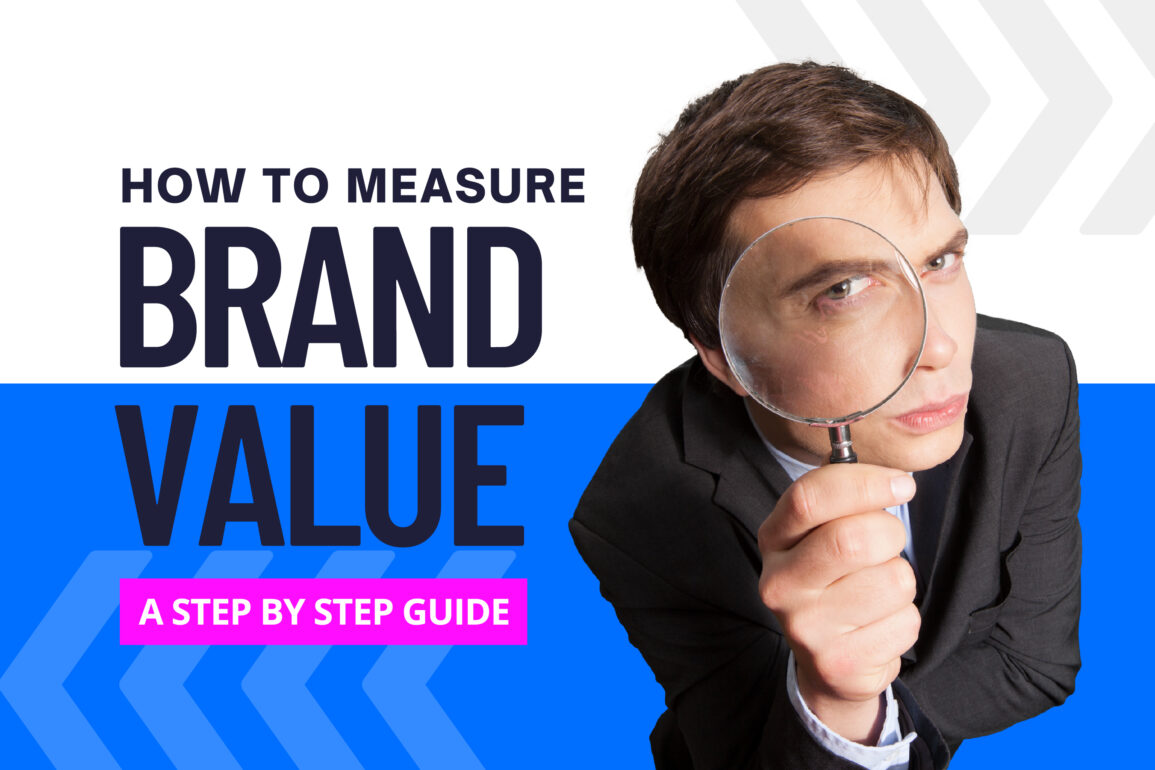How to measure brand value: Discover your brand’s worth in 3 easy steps

Learning how to measure brand value can be tough. While your brand strength, or brand worth is crucial to your company’s success, it’s not as easy to quantify as new customers, revenue, or profits.
The value of a brand relies heavily on intangible assets, such as brand equity, customer perception, and loyalty. There’s a lot of “reading between the lines” to deal with.
But just because a brand valuation can be difficult, doesn’t mean it isn’t important.
In recent decades, measuring brand value has become essential to identifying a company’s chances of success. In the past, consumer choices were largely based on the value and quality of a company’s products. However, the advertising boom of the 1960s changed all this.
Company identities became household names, and consumers started using brand names as a proxy for desirable characteristics they wanted to be associated with.
Nowadays, people don’t just buy Apple phones because they want the latest tech. They want to be connected with ideas like innovation and sleek design.
So, how do you measure brand value? Let’s find out.

What is brand value? Brand value definition
Brand value is how much your brand would be worth financially if you sold it.
Now here’s where things get tricky.
We’re not just talking about how much you could sell your company and its products for. That’s a whole different ball game. We’re talking how much a buyer would pay to use your name, logo, brand personality, and all the other assets that make up your brand identity.
The amount someone would pay to buy access to Coca-Cola’s formula for its famous soft drink is very different to what they’d pay to use every aspect of Coca-Cola’s identity.
One way financial experts and business owners look at this is to figure out how much it would cost to rebuild your brand from scratch, and elevate it to the same level it’s at now. If you sold an unknown company and wanted to create a new one, there’d be some basic costs to consider.
You’d need to pay for a designer to make your logo, maybe a website, and some simple marketing support. If you sold “Google” and wanted to create another search engine with the same impact, you’d need to invest in years of development, growth, and marketing.
See the difference?

Brand value vs brand equity: What’s the difference?
Another thing that makes it difficult to define brand value is that many people assume brand value, and brand equity are the same thing.
After all, they’re both connected to the worth of your brand, right?
Sort of. When you learn how to measure brand value, you examine the entire worth of your brand from a financial perspective, based on a bunch of different factors.
When you measure brand equity, you’re looking at how customers perceive your brand. In other words, how often do customers choose your brand name over the competition. How many loyal customers do you have that are willing to advocate for your company?
Brand equity has an impact on the value of your brand. After all, when you have strong brand awareness and recognition, and an active community of fans, your business is more profitable.
The more customers love your company, the more repeat sales and revenue you make. However, a brand can also have value without having positive brand equity.
Your brand would still be worth something if it created a compelling product with the potential to drive loyalty. It just won’t have as much financial value as a company that has already earned significant brand recognition through things like a comprehensive marketing strategy.

Calculating brand value: The elements of brand value
Ok, so now know the basics of what “brand value” means – but let’s dive a little deeper.
The value of your brand is dependent on a bunch of different factors (including brand equity). If you were going to sell your brand tomorrow, you’d look at a few different things to determine how much you should charge your buyer.
These factors include:
- Brand equity: How customers perceive your brand. Are your brand values and mission aligned with your audience? How positive is your reputation?
- Customer loyalty: Based on strong brand equity, do you have a loyal customer base? Will your customers always choose your particular brand over another?
- Product or service quality: How much value do customers assign to your products and services? How impactful are your solutions, and can you charge a price premium for them?
- Brand awareness: How much reach does your brand have? How many people are aware of your company? Is your business a household name?
- Brand association: What do your customers associate your business with? Are you connected with concepts like luxury, or positive experiences?
All of these factors are connected with other important data, like the average revenue you make each year, your profit margin, and so on, to determine how much your brand is actually worth.

Brand measurement methods: Ways to calculate brand value
Brand valuation isn’t an exact science. In fact, it’s much trickier than it seems. One of the reasons most companies don’t know how to measure brand value is there are so many different ways to determine what your brand is actually worth.
Let’s take a closer look at some of the most common brand measurement methods brand owners use to define the full value of their brand.
1. Cost-based valuation
Probably the simplest way to measure brand value is to look at how much it would cost to re-build your brand from scratch. Basically, you’d add up all the expenses involved in building your company, from paying for logo design, to creating marketing campaigns.
You’d gather all of the data you can find on the expenses you’ve paid from the inception of your brand, through to now. This might include looking at ad spend, contractor salaries, employee salaries and more. This gives you a pretty clear view of how much you’ve invested into your company.
Unfortunately, cost-based valuation is pretty basic, as it doesn’t take your brand equity, customer loyalty, and brand perception into account.
2. Market-based valuation
Market-based valuation looks at the overall climate of your current market or industry to help define brand value. You’d use a competitor analysis to find out what other companies selling similar products are worth in your landscape.
You might examine stock performance, and market capitalization information for some of the most valuable brands in your industry. You can also ask leaders in other companies what they would charge for their brand, and pay for yours.
Once again, this is a helpful way to get an overview of the possible total value of your brand, but it doesn’t take all of the factors of your brand’s value into account.
3. Income-based valuation/revenue premium valuation
We’ve lumped these two methodologies together because they both look at the income made by your brand in the current moment. On a basic level, income-based valuation looks at the money your brand makes at the moment. It’s more complicated than it seems.
You’d need to look at all the financial streams supporting your company, then determine how much of your income is directly linked to your brand’s reputation.
Revenue premium valuation is a bit more specific. It involves taking what you’ve learned about your monetary value based on income, and comparing it to non-branded similar products.
4. Brand equity valuation
Brand equity valuation, or customer-based brand valuation focuses on the emotional connection you have with your audience, and how they influence your brand’s worth. You’d start by looking at factors that affect your brand’s equity, such as customer loyalty and positive perception.
You’d then assess how many current customers you have based on your brand equity, and their overall “lifetime value”. In other words, how much is the average loyal customer likely to spend with your company throughout their entire lifetime?
This is one of the most complicated ways to measure the intangible value of a brand, because it’s difficult to know for certain how consumer behavior and loyalty will change over time.
5. Net promoter score valuation
Usually, “NPS”, or Net Promoter Score valuation is combined with other ways to measure brand value, such as looking at brand equity and income. In essence, you’ll look at how well your brand inspires organic, word-of-mouth promotion.
You can use surveys to ask your customers how likely they are to recommend your brand and its products to someone they know. If your target audience is already actively promoting your company for you, this gives your brand a lot more value.

How to measure brand value: Step by step
Now we’ve looked at some of the methods of calculating brand value, let’s look at the step-by-step process for how to measure brand value. Once again, it’s worth remembering this process isn’t easy.
If you asked ten different people to use a specific “brand valuation formula” to calculate the worth of your brand, you’d probably still end up with 10 different answers. There’s always some subjectivity to think about because it’s hard to convert intangible things like loyalty into a dollar value.
Still, you can follow these steps to get a basic insight into your brand’s worth.
Step 1: Create a valuation scope
First, define all of the factors you’re going to think about to determine your brand’s value. If your company is relatively new, you’re more likely to focus on financial metrics, like revenue and profit margins, and how they compare to the results of great brands in your industry.
If your business is well-established, you may pay closer attention to your brand loyalty figures, market share, and connection with your target market.
Step 2: Choose your valuation approach
Next, choose your formula for brand valuation. When it comes to learning how to measure brand value, we often recommend using a few different calculations. Ideally, rather than just using a cost-based evaluation or a brand equity valuation, you’d combine the two.
Using multiple methods to examine the full market value of your brand will give you a more accurate figure. You can also consider working with an expert who has experience valuing brands in your industry. There are specialists who can help with things like financial analysis.
Some of the key things you should look at during your valuation include:
- Your financial standing: How much profit you generally make, the average lifetime value of your customers, the amount of money you owe to lenders, etc.
- Brand equity: The position you hold in the minds of customers, their loyalty to your company, and their ability to promote you to other consumers.
- Your investment: How much money you’ve already spent on brand building and differentiating your company from other generic brands.
Step 3: Compare your results with the competition
Once you have a basic understanding of how much your brand might be worth, it’s time to think about how it stacks up against the competition. Analyzing a competitor’s brand can give you an insight into how you can improve your brand value, or where you’re missing out on opportunities.
Determine the top competitors in your industry, and analyze their value using the same valuation approach you choose for your own brand.

How to increase brand value: 5 simple ideas
Now you know how to measure brand value, the next step is figuring out how to increase your worth. Every brand wants to maximize its value. Even if you’re not planning on selling your brand right now, investing in your brand value makes sense.
Committing to strategies that can increase brand loyalty and profits doesn’t just let you request a higher price from a buyer when you sell your company. It also ensures you can improve your balance sheet and make more money in the short term.
So, where do you begin?
1. Learn more about your target audience
While calculating brand value and determining brand equity are two different things, the relationship you have with your customers has a big impact on brand worth. Ultimately, the stronger your link to your target audience, the more valuable your business becomes.
The best way to ensure you’re building brand loyalty, and attracting the right people to your company, is to learn more about them. Send out questionnaires and surveys to find out what customers love about your brand and products.
Gather feedback using social listening tools, and ask for reviews. Calculate your “NPS” score, and find out how many customers would recommend you to another buyer.
Learning about your customers will give you insights into how you can separate your company from the competition, and create a positive customer experience that drives repeat revenue. It can even help you improve your product quality, and guide your future business strategy.
2. Upgrade your marketing and advertising
Once you’ve learned as much as you can about your audience, start investing in new ways to position your company effectively in the minds of consumers. Think about how you build brand awareness and shape customer perceptions with your marketing campaigns.
A good way to improve the impact of your marketing efforts is to start by mapping the customer journey. Find out how your target market searches for solutions to their problems. How do they learn about new companies and products, and make purchasing decisions?
Your marketing strategy should align with all the key touch points in your customer’s journey, including everything from social media campaigns, to email efforts.
Once you’ve got a view of your customer’s journey, think about how you can upgrade your marketing mix, with strategies like:
- Working with thought leaders and influencers: Aligning your company with reputable figures in your industry helps to boost brand awareness, visibility, and credibility.
- Sponsorships and ethical initiatives: Sponsoring well-known figures or non-profits, and introducing CSR initiatives can help you connect with customers on a deeper level.
- Appointing partners: Working with channel partners can help you to reach customers in different landscapes, and expand your brand reach.
3. Improve the customer experience
A lot of new brand managers make the mistake of assuming that their brand’s value relies solely on things like product features, and the visibility of their logo. However, your brand power is also reliant on how you serve and support your target audience.
A strong brand identity doesn’t mean much if your customers can’t trust you to put their interests and needs first. In fact, 88% of customers who encounter a bad customer experience stop trusting that brand. Elevate your brand strategy by putting your customer first.
Look for ways to constantly improve the interactions your customers have with your business. For instance, can you accelerate shipping times, or offer customer service on a range of channels?
You can measure your current customer experience by looking at things like your net promoter score, customer effort score, and customer satisfaction score.
4. Be transparent, and authentic
Want to know how major companies build deeper relationships with their customers? They’re transparent, genuine, and honest. We’re living in a world where consumers can easily research and learn as much as they like about any brand in just a few seconds.
If you’re not transparently sharing insights into your mission, values, and processes, then your customers aren’t going to trust you or your products. In fact, 90% of customers say a brand’s transparency is crucial to their purchasing decisions.
So be real with your target audience. Share clear information about your product development processes and supply chain. Be honest about your pricing strategy and why you charge a specific amount for each solution you sell.
Most importantly, clearly draw attention to your brand purpose, and deliver on your promises. Don’t just let your customers know what your company stands for. Actively demonstrate a commitment to living up to your values, and achieving your mission.
5. Be consistent
Brand consistency is crucial to success, particularly when you want to increase your brand value. As we mentioned above, your customer’s perception of your company has a big impact on your brand’s worth. If your messaging and image is constantly changing, how can people trust you?
Similarly, being consistent with your branding is crucial to building awareness. The more people see you using the same colors, logos, and marketing messages, the more familiar your company becomes.
Start by setting out some brand guidelines. Think about what tone of voice you’ll use in your brand materials, what colors will appear on your brand assets, and which channels you’ll use to connect with brands. Think about the slogans and taglines you use to inspire customers, like Nike’s “Just do it”.
Remember to be consistent with your products too. The quality of the product you sell should always align with your customer’s expectations.
Calculate and improve your brand’s value
Learning how to measure brand value is tricky. There are numerous ways to calculate how much money your company makes, and how much revenue you earn from a specific product. But defining your brand value is a completely different process.
There are various key factors that contribute to how much your brand is actually worth. It’s not just how much profit you make, but also customer loyalty, brand equity, and your company’s overall impact that contributes to the value of your brand.
However, as complicated as calculating brand value can be, it’s still crucial to your company’s success. Understanding your brand value is the first step to improving it.
Once you know how much your brand is actually worth in the ideas of your consumers, investors, and stakeholders, you can begin cultivating additional value.
Ready to start building brand value? Reach out to Fabrik today to see how we can help you develop the assets of a truly lucrative brand.
Fabrik: A branding agency for our times.
















